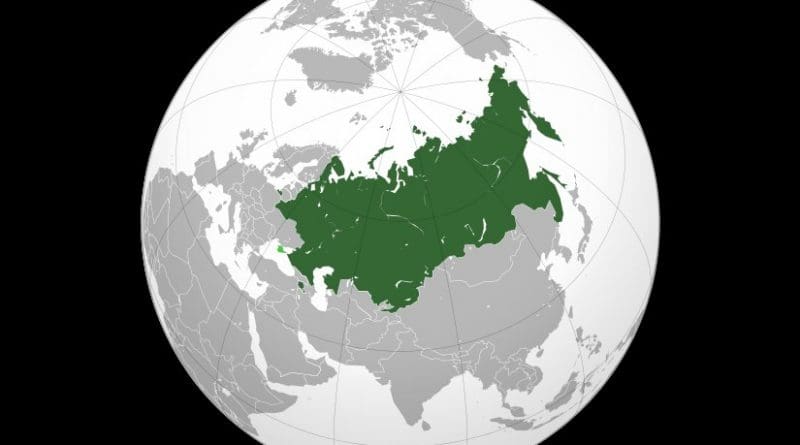Eurasia’s Economic Union And ASEAN: Why Interaction Is Important – Analysis
By RSIS
Members of the emerging Eurasian Economic Union (EEU) are reaching out to Southeast Asian countries to balance China’s growing influence in Eurasia. What are the implications for ASEAN?
By Aidar Amrebayev*
President Vladimir Putin, at the Russia-ASEAN Summit in the Black Sea resort of Sochi in May this year, talked about the activation of relations between Russia and ASEAN. Earlier, at the Astana summit of the Eurasian Economic Union (EEU), the Kazakhstan president proposed to all countries to devote this year to the cooperation with other international associations, including ASEAN. A month later, at the June summit of EEU, the Shanghai Cooperation Organisation (SCO) countries discussed the possibility of cooperation between EEU, SCO and ASEAN.
Two key questions arose: Firstly, why are the former post-Soviet states leaning in the direction of ASEAN? Secondly, what are the opportunities and obstacles in cooperating with ASEAN?
Western Sanctions against Russia
The EEU is a common economic space comprising countries with transition economies, transiting political systems and have not determined their final national identities. A serious technological lag and the raw nature of the economies, along with the authoritarian political systems, seriously limit the possibility of the regional grouping’s dynamic entry into the global economic and political processes.
While the EEU has great economic potential, the domineering presence of Russia, a country with global ambitions and nuclear weapons, could pose complications for the EEU members and other post-Soviet states that have yet to join the grouping. This is especially so should Russia seek to construct a non-Western model of world order, and adopting a confrontational relations with the West on a range of issues.
Nevertheless, the problem of the modernisation of post-Soviet states is far more urgent and challenging. Frankly, the alternatives for further development are limited. The Western sanctions against Russia cut off this part of Eurasia from the European way of development and stimulate it to turn to the East. This development has thrown up different possibilities as well as risks.
China’s Silk Road Economic Belt
The Asian part of the former Soviet Union is turning out to attract growing attention from China, particularly under the “One Belt, One Road” strategy. Therefore, national economic development strategies of a number of Central Asian countries are tied to the perspective of participation in the Silk Road Economic Belt (SREB) and are counting on generous investment from Beijing. Intuitively, this can be seen in the new economic programme of Kazakhstan “Nurly Zhol” / Shining Path, which is totally oriented towards infrastructure projects with China.
This is the reason why there is growing Chinese investment in Kazakhstan. The total amount of Chinese investment in Kazakshtan (US$23.6 billion) surpassed that from Russia (not more than $7 billion) in 2015. In total, China intends to invest about $40 billion in the programme of SREB. Another source of investment for this project is the China-initiated Asian Infrastructure Investment Bank (AIIB) initial capital of $100 billion.
In spite of Russia’s competition with China for influence in Central Asia, in a situation of crisis, current Russian development models, and reducing the overall capacity of influence, Russia declared its own strategy to “turn to the East”. But this strategy has some specifics. The first is to use financial resources for development through the participation in the Chinese project. The second is to balance Chinese influence through cooperation with ASEAN countries.
In May last year, Russia signed an agreement on the partnership between the EEU and China’s SREB. EEU leaders reaffirmed the need to develop a coherent collective approach in this direction. Russia also initiated the expansion its “East way” through a diversification of its Eastern policy. For example, Moscow uses different formats, like the SCO with new members – India and Pakistan. Soon Iran, BRICS and ASEAN countries like Vietnam will be approached.
Reaching Out to ASEAN
Central Asian countries, in their own limited external economic manoeuvre, are trying to exercise a diversification strategy in foreign policy and economic development. Thus, Kazakhstan signed an agreement with the European Union (EU) late last year on the expansion of partnership while EEU member states approved the Agreement on Free Trade Zone with Vietnam.
Negotiations on a free trade area (FTA) in the Eurasian Economic Commission (the executive body of the EEU) are carried out with some other countries, including representatives of ASEAN. In contrast, the establishment of an FTA with China is still at the stage of bureaucratic conversations without much enthusiasm on the part of the Eurasian officials.
Interestingly, against the background of China’s military-political activity in the South China Sea, these actions by the Chinese partner may be considered controversial, but the EEU’s desire to cooperate with the countries of ASEAN is serious because of the need to balance Beijing’s growing influence in Central Eurasia. Several factors can support the EEU’s new policy such as the growth of international trade between EEU and ASEAN; the formation of a stable legal and regulatory framework of interaction; and the creation of successful cooperation projects, especially in advanced technologies.
For the Central Asian states, one area of particular interest may be the experience of ASEAN in forging integration with different political and economic models of development. Central Asian states could possibly create their own regional platform similar to ASEAN to resist the expansion of China, Russia or America. Cooperation between Central Asian countries and ASEAN to develop a free trade agreement could be one alternative to Chinese domination in Central Asia.
*Aidar Amrebayev is the head of the Centre of Applied Political Science and International Studies in Almaty, Kazakhstan. He is currently a Senior Visiting Fellow with the China Programme at the S. Rajaratnam School of International Studies (RSIS), Nanyang Technological University, Singapore.

